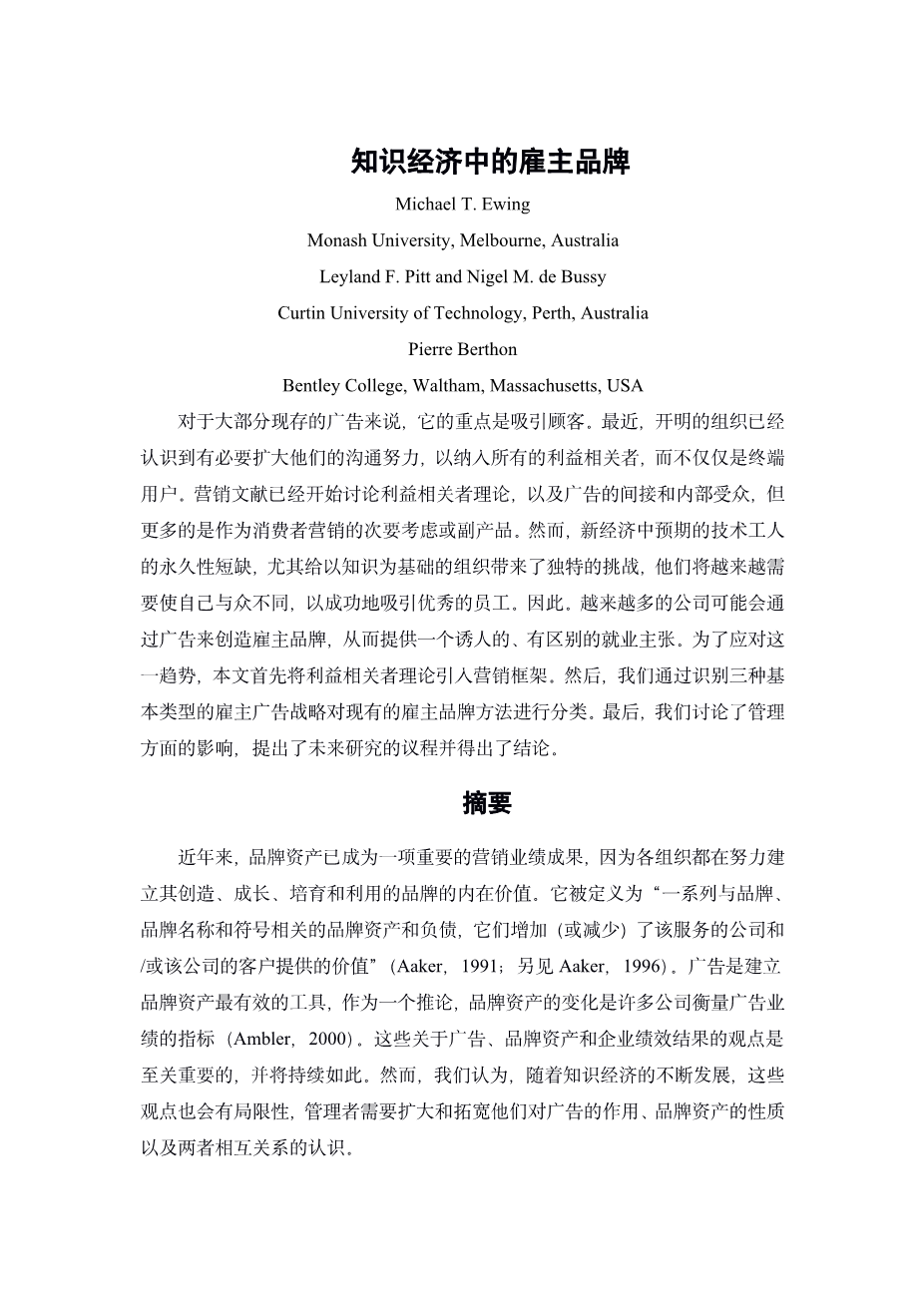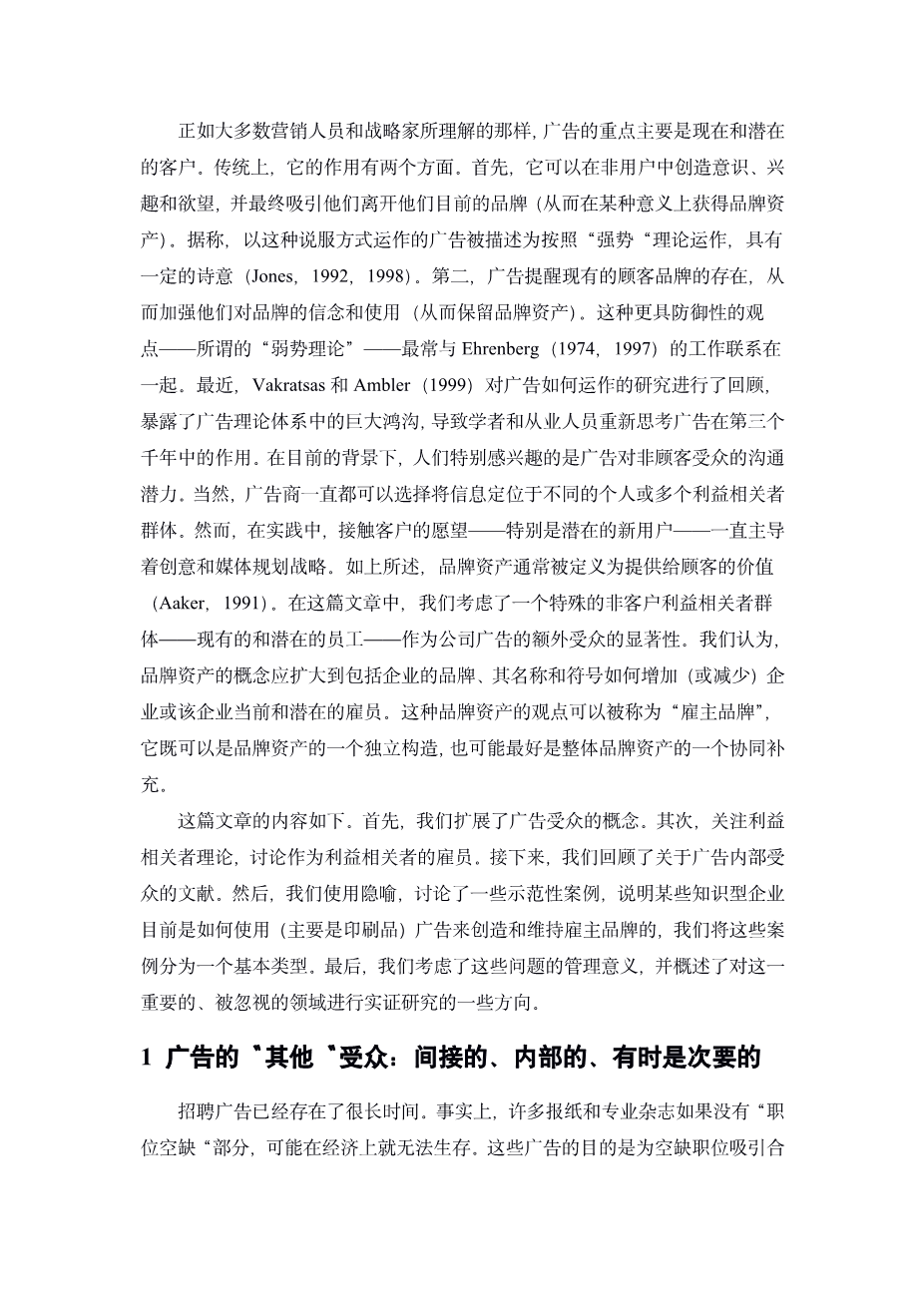知识经济中的雇主品牌外文翻译资料
2023-04-17 21:15:03
Employment branding in the knowledge economy
Michael T. Ewing
Monash University, Melbourne, Australia
Leyland F. Pitt and Nigel M. de Bussy
Curtin University of Technology, Perth, Australia
Pierre Berthon
Bentley College, Waltham, Massachusetts, USA
For most of its existence advertising has focused on attracting customers. More recently, enlightened organisations have recognised the need to expand their communications efforts to incorporate all stakeholders, not only end-users. The marketing literature has begun to address stakeholder theory, as well as advertisings indirect and internal audiences, but more as a secondary consideration or by-product of consumer marketing. However, the anticipated permanent shortage of skilled workers in the new economy creates unique challenges for knowledge-based organisations in particular, who will increasingly need to differentiate themselves in order to successfully attract talented employees. As a result, more and more firms may turn to advertising to create employment brands and thereby offer an enticing vocational proposition that is compelling and differentiated. In response to this emerging trend, this article begins by introducing stakeholder theory into a marketing framework. We then classify existing approaches to employment branding by identifying three basic types of employment advertising strategies. In closing, managerial implications are discussed, an agenda for future research is proposed and conclusions are drawn.
INTRODUCTION
Brand equity has become a critical marketing performance outcome in recent years, as organisations strive to build the value inherent in the brands they create, grow, nurture and exploit. It has been defined as a set of brand assets and liabilities linked to a brand, its name and symbol, that add to (or subtract from) the value provided by a product or service to a firm and/ or that firms customers (Aaker, 1991; see also Aaker, 1996). Advertising has been the tool most prominently utilised to build brand equity, and as a corollary, changes in the brands equity are the metrics by which advertisings performance has been (or should be) gauged in many firms (Ambler, 2000). These views of advertising, brand equity and the performance outcomes of firms are critical and will remain so. However, we contend that as the knowledge economy continues to evolve, these perspectives will also be restrictive, and that managers will need to expand and broaden their perceptions of the role of advertising, the nature of brand equity, and the interrelationships between the two.
As most marketers and strategists understand advertising, its focus has primarily been on present and potential customers. Its role has, traditionally, been twofold. First, it can create awareness, interest and desire among non-users, and ultimately entice them away from their current brand/ s (thus in a sense acquiring brand equity). Advertising that is purported to work in this persuasive way has been described with some poetic licence as functioning according to the strong theory Jones, 1992, 1998). Second, advertising reminds existing customers of the brands presence, and thus reinforces their belief in and use of it (thus retaining brand equity). This more defensive viewthe so-called weak theory - is most commonly associated with the work of Ehrenberg (1974, 1997). More recently, Vakratsas and Amblers (1999) review of research into how advertising works has exposed vast chasms in the body of advertising theory, leading scholars and practitioners to rethink the role of advertising in the third millennium. Of particular interest in the present context is advertisings potential to communicate to non-customer audiences. Of course, advertisers have always had the option of targeting messages at a diverse range of individual or multiple stakeholder groups. In practice, however, the desire to reach customers - in particular potential new users - has dominated both creative and media planning strategies. As discussed above, the concept of brand equity itself is commonly defined in terms of value provided to customers (Aaker, 1991). In this article we consider the salience of one particular noncustomer stakeholder group - present and potential employees - as an additional audience of the firms advertising. We argue that the concept of brand equity be expanded to encompass how a firms brand, its name and symbol add to (or subtract from) the value provided by the firm and/ or that firms current and potential employees. This view of brand equity may be referred to as employment branding, and it can be either a separate construct of brand equity, or perhaps preferably, a synergistic addition to overall brand equity.
The article is set out as follows. First, we expand the notion of the advertising audience. Second, attention is given to stakeholder theory, discussing employees as stakeholders. Next, we review literature on advertisings internal audience. Then, using metaphors, we discuss a number of exemplary cases that illustrate how certain knowledge-based firms are currently using (primarily print) advertising to create and sustain employment brands, and we categorise these into a basic
typology. We conclude by considering the managerial implications of these issues, and by outlining a number of directions for empirical research into this important and somewhat overlooked domain.
ADVERTISINGS OTHER AUDIENCES: INDIRECT, INTERNAL AND SOMETIMES SECONDARY
Recruitment advertising has been around for a long time. Indeed, many newspapers and professional magazines would probably not survive financially without the Situations Vacant section. These ads have the intention of attracting suitable applicants to vacant positions, not
剩余内容已隐藏,支付完成后下载完整资料


英语译文共 11 页,剩余内容已隐藏,支付完成后下载完整资料
资料编号:[588923],资料为PDF文档或Word文档,PDF文档可免费转换为Word




